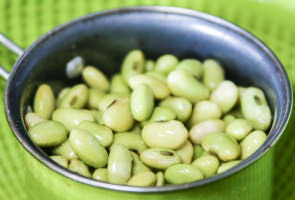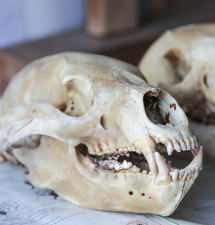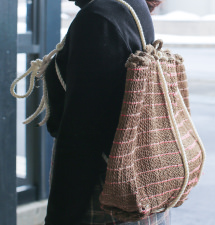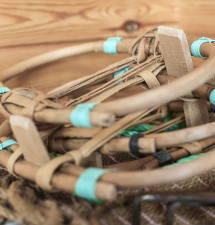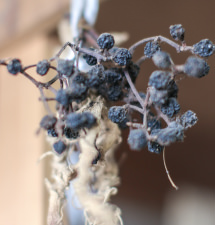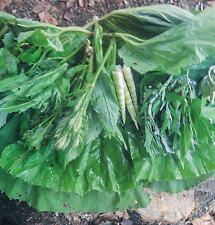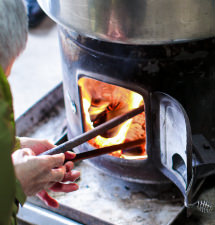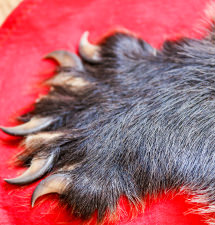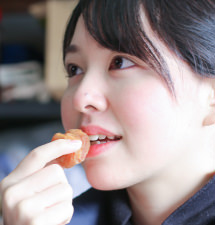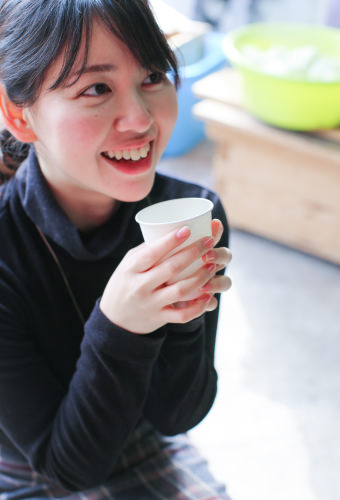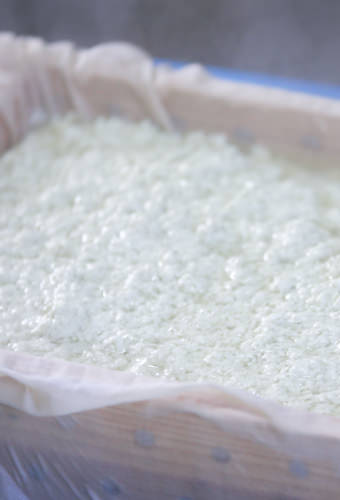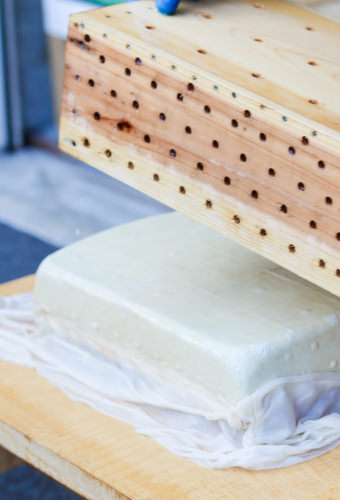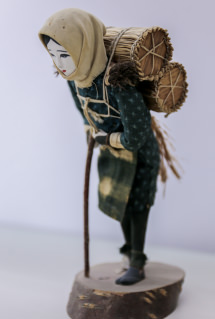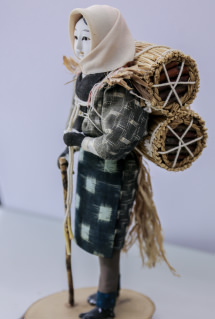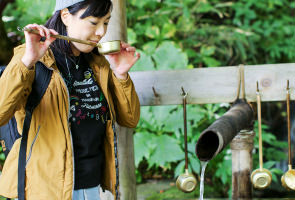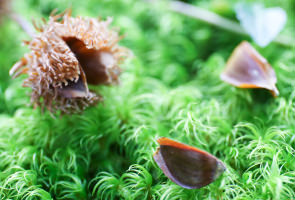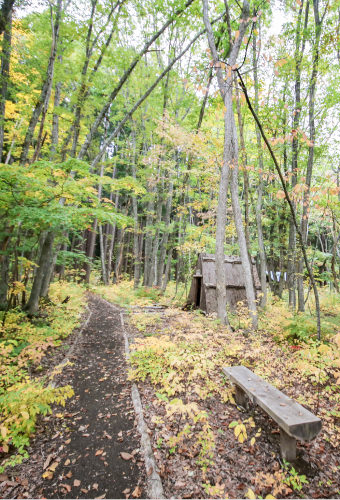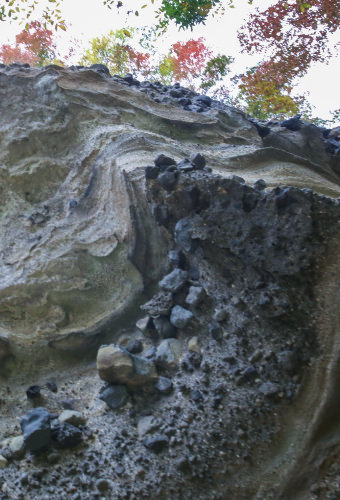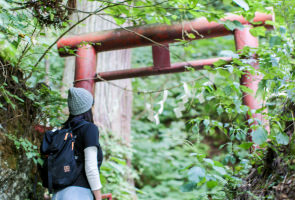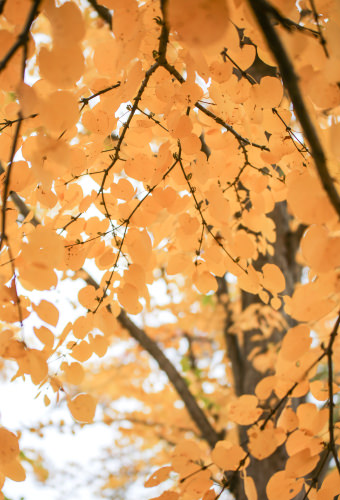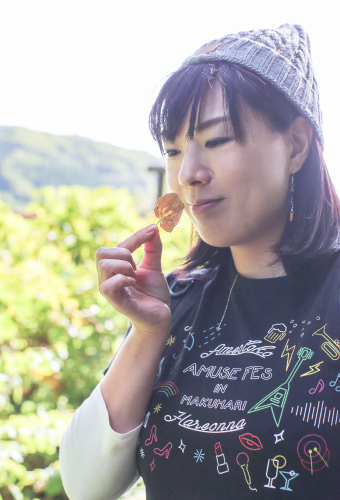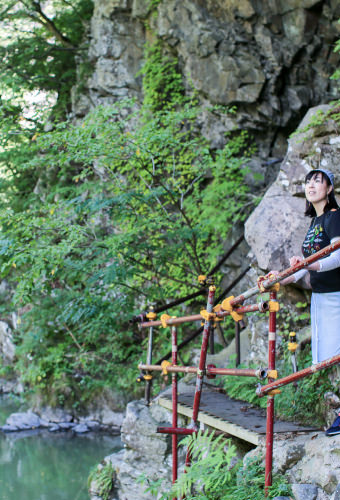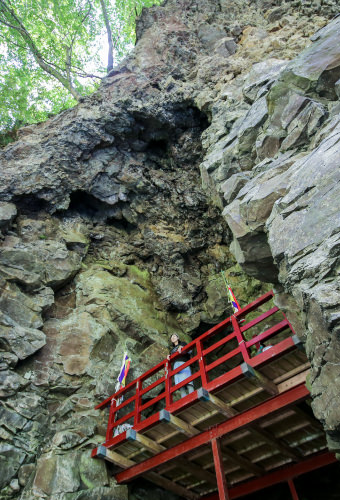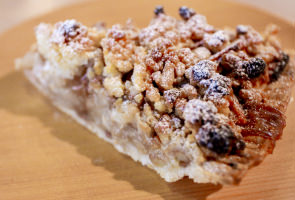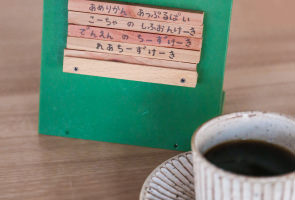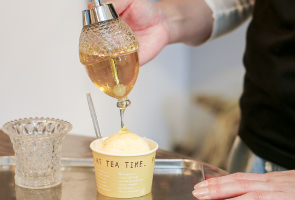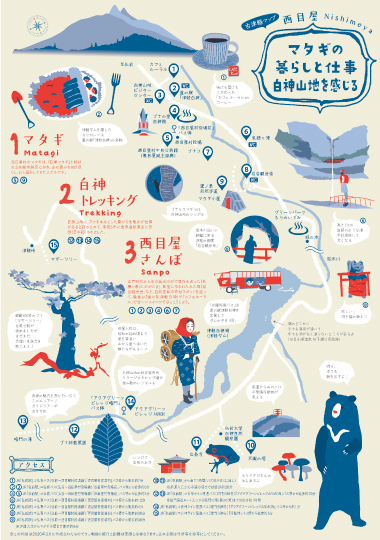The Life and Work of the Matagi, Feel Shirakami Sanchi
NISHIMEYA
Nishimeya is a village in the UNESCO Natural World Heritage Site Shirakami Sanchi. Shirakami Sanchi is a mountainous region with a rich ecosystem and large virgin beech forest where Japanese hunters known as matagi survived by hunting bears, gathering mountain vegetables, and making charcoal. The site of the largest excavation of Jomon-period remains in Aomori is also located at the heart of Nishimeya. From this and other examples, we can understand that people have continuously lived together with the nature of Shirakami from ancient times to today.
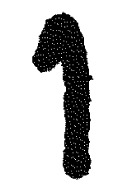
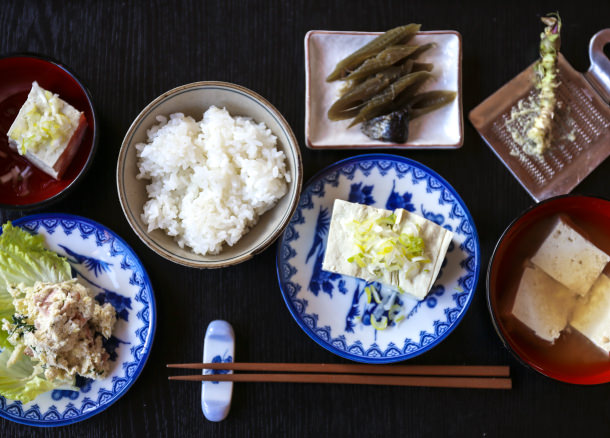
1 Meya Matagi
Surviving in the grand mountains
The matagi of nishimeya are called ‘meya matagi’. They are a people who have lived in the mountains until today, knowing all there is to know about the area and roaming freely there. In spring, they gathered buds of the fuki plant and angelica sprouts. In summer they picked osmunda fern, sasa sprouts, warabi, and mizu nettle, and fished for charr and cherry salmon. In autumn they search for mushrooms such as maidake and samodashi, as well as various nuts and fruits from trees. In winter, they hunt small animals such as hares and copper pheasant, but only as much as they need to survive and with all with reserved grattitude. As the snow melts, there is a brief period where the matagi allow themselves to hunt bear, which they call blessings from the gods. All of this is done while protecting the customs of the mountains. Matagi do not solely subside on hunting and gathering, they also cultivate rice and vegetables in the village where they reside.
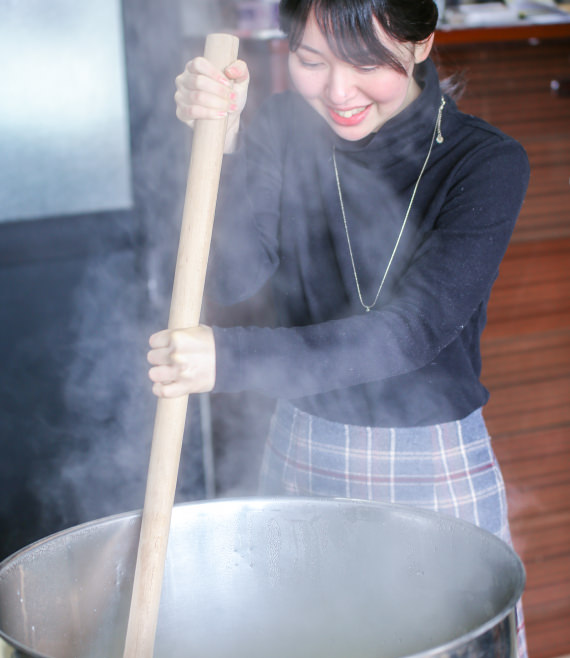
Tofu made in the depths of winter at the matagi sha
You can try making traditional Nishimeya Tofu on a “Matagi Sha Tour.” Matagi make their own tofu from organicly grown beans. The beans used to make the tofu are chosen to reflect the beans that matagi would use in the past, including soybeans, edamame, and dadacha soybeans. The tofu is made from December until March, as colder periods are more suitable for making it. This was also to help preserve the tofu during a time when they still didn’t have refrigerators. It is said that long ago, the matagi would gather at a small hut used for making tofu on the night of a full moon to hold a feast. The beans are heated over firewood and mixed with a tool called a konagi, and you can tell the tofu is ready by its smell and appearance. *A konagi is a wooden stick similar to the oar of a boat. They are made for various tasks and can be used as ladles for serving food, canes for trekking through the snowy mountains, sticks to stir a large pot, and more. The matagi make them in many different sizes for different purposes, but they are all called konagi.
Steaming hot
Fresh tofu
Tasting time begins partway through the tofu making process. Try out dried beancurd, soy milk, soft yose tofu from before it thickens, and more. Beechnuts and plums used to make alcohol, various medicinal herbs, and other treats may also be served. It is truly a feast of the mountain’s blessings. Pictured above, from left to right: A bear skull, a cord kodashi (small bag for carrying mountain vegetables), a kanjiki (a tool used to walk in the snowy mountains), Amur-cork tree nuts, spring mountain vegetables, a wood fire stove, a bear paw, and an alcohol-pickled plum.
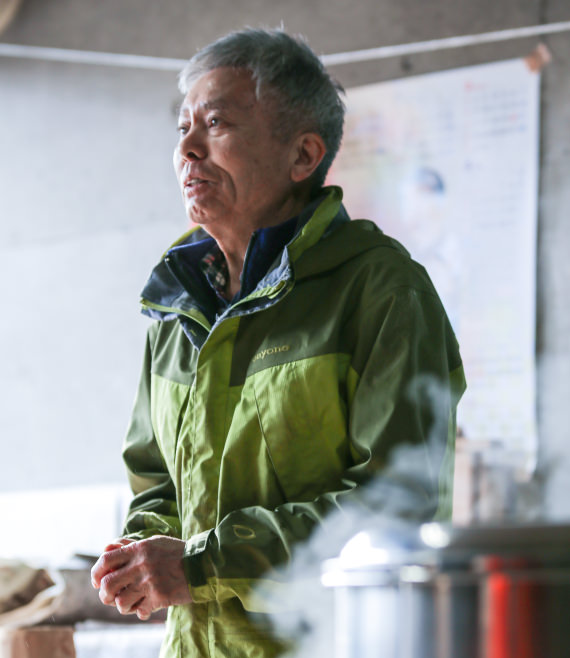
Every time you pull the trigger, become a demon The origin of the Matagi
According to the previous leader of the matagi, matagi must not kill any animal that does not show ill intent. If a matagi is to kill, they must aim to ‘become a demon’ and kill the animal in an instant to prevent the animal from suffering at the very least. Each time the matagi hunt, they must become a demon, and the name matagi is said to come from the Japanese word for ‘again’ (mata) and demon (ki). The matagi were able to live in the mountains for a long time, but once Shirakami Sanchi was registered as a UNESCO World Heritage Site, the land on which they could hunt or gather vegetables was greatly reduced. The continued existence of the matagi was endangered, so they created the facility “Shirakami Matagi Sha” to pass on their wisdom gained by living together with nature. In the past, the matagi would enter the mountains year-round with no effect on the ecosystem. On Matagi Sha Tours, they pass on the importance of protecting nature.
Food tastes more delicious when made with handmade tools
These wooden boxes used to make tofu without fail are handmade by the matagi. A number of holes in the box leave impressions, which can be seen on the tofu. The matagi are quite skilled at woodworking, and they make all of the tools they can’t live without, such as the konagi mentioned above.
- Shirakami Matagi Sha Tours
- Contact: Shirakami Matagi Sha
- Tel. 0172-85-2628(8;00~22:00)
-
Tour Meeting Spot (One example):
219-1 Kanda, Tashiro, Nishimeya, Nakatsugaru District, Aomori Prefecture
Michi-no-Eki Tsugaru Shirakami Beech Nishimeya
From Hirosaki Bus Terminal, take the Konan bus Nishimeya-mura Yakuba-mae Line. 5-minute walk from Nishimeya-mura Yakuba-mae bus stop.
Shirakami Matagi Sha Website
http://matagisha.sakura.ne.jp/
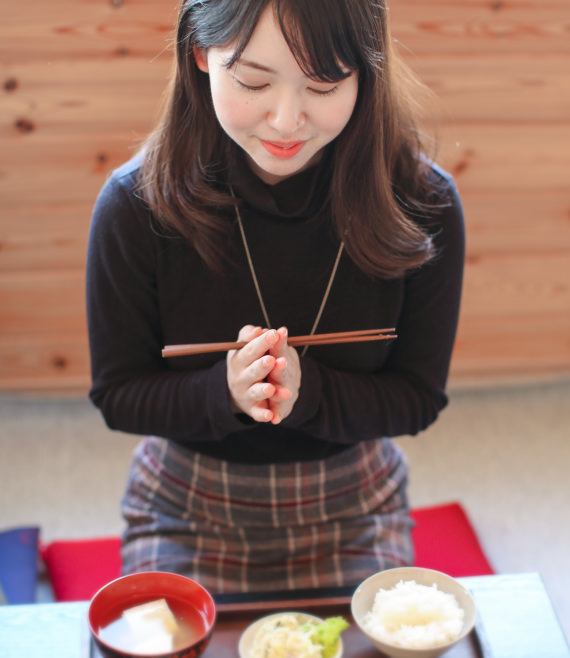
Sharing the blessings of the mountains with others
Hiyayakko tofu, yudofu, tofu in miso soup, and tofu dregs as okara on a salad, this feast of tofu may be simple, but it is exquisite. Dig in!
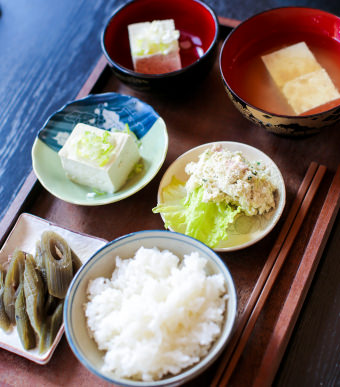
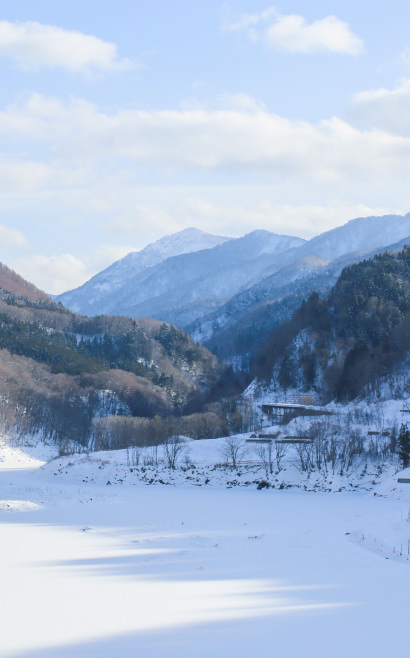
From the depths of the mountains out to the village Girls carrying charcoal on their backs
Known as Okumeya, the area at the rear of Nishimeya where the matagi used to live now lies at the base of a large dam. Long ago, there were many businesses producing charcoal here. However, because it is deep in the mountains, horses were not used to ship the charcoal. Instead, until the beginning of the Showa period, charcoal sacks were carried to the village by people. The ‘Meya Doll’ pictured on the left is modeled after the young women who would carry the heavy bundles of charcoal on their backs through the mountains. Dolls of women wearing floral-patterned farming clothes and covered heads were made at the beginning of the Showa period and were sold as Local craft goods in Hirosaki and Tokyo.

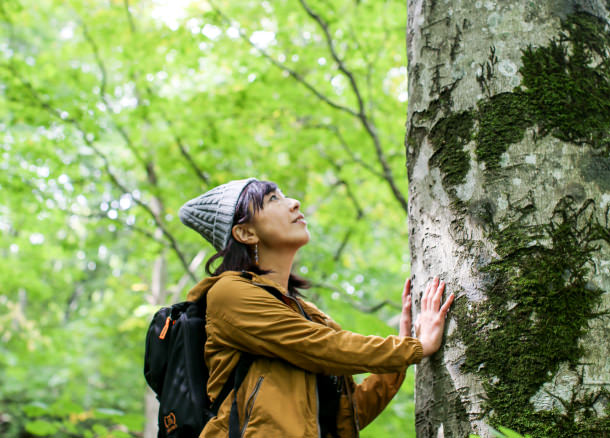
2 Shirakami Trekking
Walk the Beech Forest Trail
Shirakami Sanchi is the largest virgin beech tree forest in Eastern Asia. With beech trees as the main focus, the rich ecosystem was recognized as having significant value and was registered as a UNESCO Natural World Heritage site (First in Japan) in 1993. The World Heritage Beech Forest Trail is within the ‘buffer zone’ of the world heritage site but is maintained as a hiking trail and is easy to walk. If you look up in the beech forest on a sunny day, you can see the light shining through the trees and feel like you are being showered in green. There are ways to enjoy the beech forest on rainy days, too; the green colors of recently-watered plants become even deeper, and they look full of life. You can drink water from the beech forest at the entrance of the hiking trail.
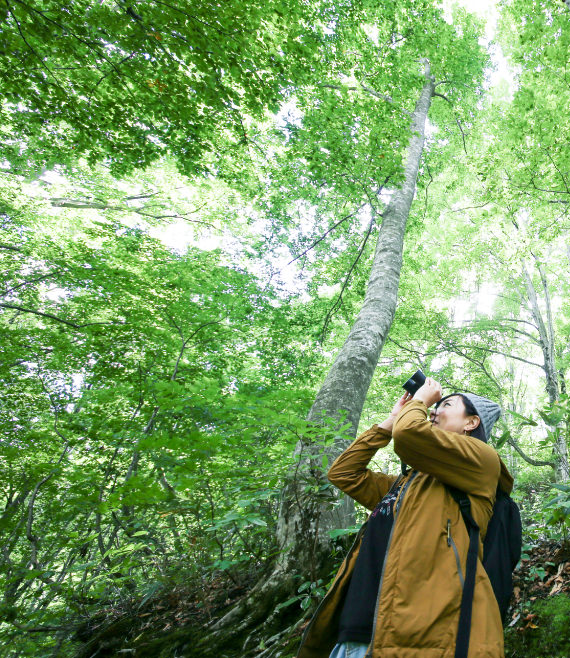
Bears love beechnuts too
In the beech tree forest, from the microbacteria that break down molds, to the insects that eat the molds, to the birds that eat the insects as well as nuts and flowers, to the reptiles, to the mammals and more, there is a relationship of eating, and being eaten. This is an ecosystem. Beech trees only grow nuts once every few years, but bears and Japanese dormouse also love them because they are delicious and nutrient-rich. The nuts aren’t bitter, so even humans find them extremely tasty. Bears are able to survive in Shirakami Sanchi because of the beech trees, and because there are bears, the lifestyle of the matagi also exists. Beech trees create an easy to live environment for animals, and it is said that they can calm the heart and erase stress for humans too.
- World Heritage Beech Forest Trail
- Hiking permitted: Late-April to early November
- Contact: Aqua Green Village ANMON
- Tel. 0172-85-3021
-
Kokuyurin-nai, Kawaratai, Nishimeya, Nakatsugaru District, Aomori Prefecture
Take the Konan Bus Shirakami line. 10-minute walk from Aqua Green Village ANMON.
*Closed from November to May

The secluded Anmon Falls
Anmon Falls, a series of three waterfalls that are 26m, 37m, and 42m tall, lies in the heart of Shirakami Sanchi. There are records of travel writers visiting during the Edo Period, but it has been known as a land of mystery that many wished to visit since long ago. A trail is currently maintained as far as the second waterfall, but because the valleys are deep and some places cross over marshes or streams, it may be best for beginners and solo-hikers to skip. We recommend going on a tour with a specialist guide. At Aqua Green Village ANMON there is a corner where you can rent Montbell helmets and hiking boots.
- Anmon Falls
- Hiking permitted: Early June until early November.
- Contact: Aqua Green Village ANMON
- Tel. 0172-85-3021
-
Take the Konan Bus Shirakami Direct Line and get off at the Aqua Green Village ANMON bus stop.
*About a 10 minute walk to the Anmon Valley Route trailhead. It takes about 1 hour by foot from the trailhead to the third waterfall.
*Closed from November to May
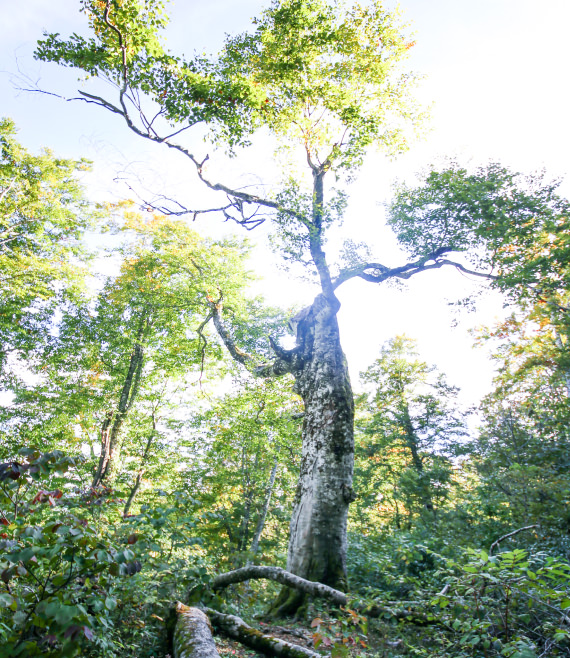
Even broken, the tree shows its vitality
Mother Tree
Beech trees typically have a life-span of 300 years, but the Mother Tree is estimated to be about 400 years old. The tree has a beautiful shape and has become a symbol of Shirakami Sanchi, having grown over its long life with a trunk just under 5m wide and standing at about 30m tall. However, the tree was broken at a spot about 9 meters high when a typhoon hit in 2018. Even so, the remaining branches sprouted new leaves, and the tree made its stalwart determination to continue living on felt. The area where the tree broke off brought in more light that will allow younger trees to grow. Currently, you can see the changing of generations in this several-hundred-year-old forest. The broken trunk now lies next to the tree.
- Mother Tree
- Hiking permitted: June to early November
- Contact: Aqua Green Village ANMON
- Tel. 0172-85-3021
-
Kokuyurin-nai, Kawaratai, Nishimeya, Nakatsugaru District, Aomori Prefecture
Take the Konan Bus Shirakami Direct Line and get off at the Tsugaru Gedo bus stop and walk for 5 minutes.
*Closed from November to May
A small matagi hut and a rock face
Takanosu Nature Path
To reach the Takanosu Nature Trail, park at the Iwaya Kanzeon parking lot, cross over the suspension bridge, and continue onto the forest on the other side of the cliff. Continue forward as you look over the restored matagi hut and small charcoal workshop, and you will arrive at a rough and angled cliff face. It is said that long ago, northern goshawks would dwell in the holes scattered about the rock face. The northern goshawks would drive off small animals looking for produce, so the people in the village treasured them.
- Takanosu Nature Trail
- Yamashina, Tashiro, Nishimeya, Nakatsugaru District, Aomori Prefecture
- Contact: Nishimeya Village Hall
- Tel. 0172-85-2800
-
From Hirosaki Bus terminal, take the Konan Bus Nishimeya-mura Yakuba-mae Line. 30-minute walk from the Nishimeya-mura Yakuba-mae bus stop.
*About 5 minutes from the trailhead to the matagi hut
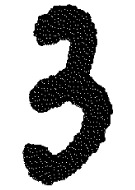
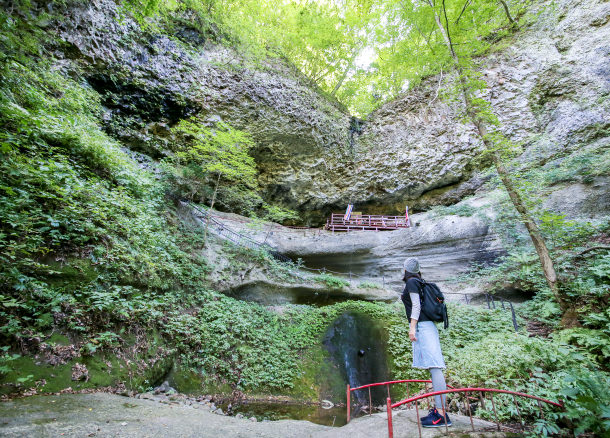
3 A stroll in Nishimeya
Niogataki Falls A place of mystery
Will it freeze? Will it not? Visit the fortune-telling Niogataki Falls. Passing through the torii gate, you will enter a dimly-lit space where the trees block out the sun, even at mid-day. Looking ahead, you’ll see a 33m tall waterfall! Near the top of the waterfall is a cave where the Buddhist deity Acala is enshrined. Niogataki Falls is named after the white, spike-shaped ice formation that occurs in winter there. Since the Edo period, the formation’s width and shape have been used to predict the quality of the year’s harvest. The Niogataki Ice Festival is held every year on the third Sunday of February, and various rites (e.g. fire purification, fire walking, etc.) are performed there.
- Niogataki Falls
- Contact: Nishimeya Village Hall
- Tel. 0172-85-2800
-
Tashiro, Nishimeya, Nakatsugaru District, Aomori Prefecture
From Hirosaki Bus Terminal, take the Konan bus Nishimeya-mura Yakuba-mae Line. 12-minute walk from Nishimeya-mura Yakuba-mae bus stop.
The smell of caramel? Katsura trees in late-autumn
A sweet smell floats through the air of the mountain village when October arrives. This smell comes from the fallen leaves of the katsura, a tall deciduous tree. The smell is similar to caramel, vanilla, and other sweets. When the leaves fall and dry out, the aroma becomes even more potent. Katsura trees prefer areas with plenty of water and grow well alongside river-valleys. In Nishimeya, this includes areas such as Green Park Mori-no-Izumi at the exit of Iwaya Kanzeon. The statue of the buddha at Kashima Shrine (founded in 1200) located next to Green Park Mori-no-Izumi has a Buddhist statue that is said to have been carved from a katsura tree by Sakanoue Tamuramaro. Be sure to look for a cute, heart-shaped leaf from a katsura tree while you visit Nishimeya!
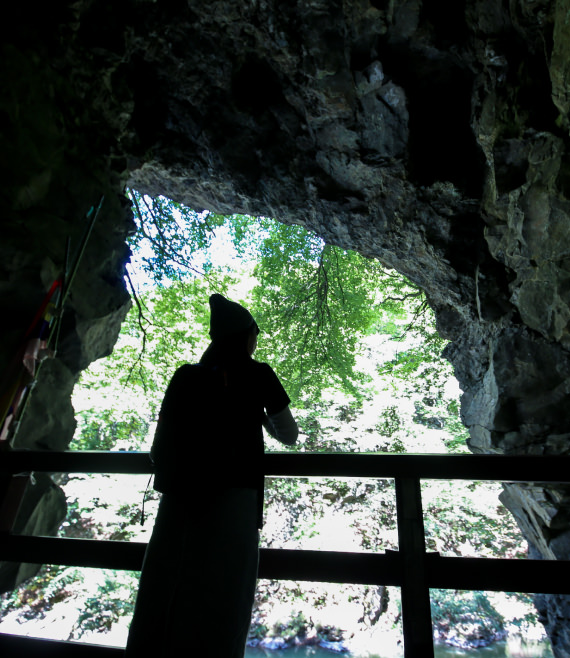
Almost too mysterious
Iwaya Kanzeon
If you pass through the red torii gate and follow the walking path that runs through the forest, you will be able to see the surface of a river just beyond the trees. Different from the Iwaki river, which lazily flows across the Tsugaru plain, this river flows through a ravine with steep cliffs on either side. (Popular spot for autumn colors) If you follow the wooden stairs down close to the river, the path will narrow until you can just barely walk one by one, winding around the rock face in a way that you can’t see ahead. Proceeding carefully along the thrilling path with pipe handrails, you will enter a cave with a red worship hall. If you climb the ladder, you will find a small shrine, and water flows freely from a spring. It is also lovely to look out at the beautiful valley through the black frame of the cave.
- Iwaya Kanzeon
- Contact: Nishimeya Village Hall
- Tel. 0172-85-2800
-
Tashiro, Nishimeya, Nakatsugaru District, Aomori Prefecture.
From Hirosaki Bus terminal, take the Konan bus Nishimeya-mura Yakuba-mae Line. 30-minute walk from Nishimeya-mura Yakuba-mae bus stop.
Trading its life to save another’s, The horse that is mourned in the cave
At the red torii gate near the entrance, there is a rare guardian horse statue (Sacred horse statue) and a statue of a beckoning cat. While horses are the mounts ridden by the gods, they have also been valuable helpers to farmers since long ago. There is a story about a cherished horse at Iwaya Kanzeon as well. A sacred horse with two horns was carrying its rider when they suddenly fell. The horse sacrificed itself to save its rider’s life, so a small shrine was built to mourn the horse’s spirit here.
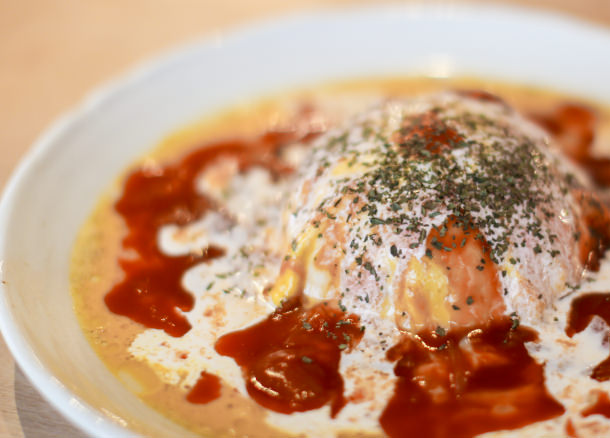
Feel the atmospehere of a secret getaway
Café Rural
Located in the residential area just behind Michi-no-Eki Tsugaru Shirakami, Café Rural has the atmosphere of a secret getaway. The owner, a local from Hirosaki, decided to open a café here after first visiting Nishimeya. It is overflowing with items made by respected craftsmen, from the lamps to the tables and chairs, to the plates and even the coffee cups. The Toro-ri Omurice (950 yen with drink) shown in the photo features tomato sauce and fresh cream interlocking over a fluffy fried omelet. It’s a place where you can relax by listening to the ticking of the wall clock while drinking delicious coffee.
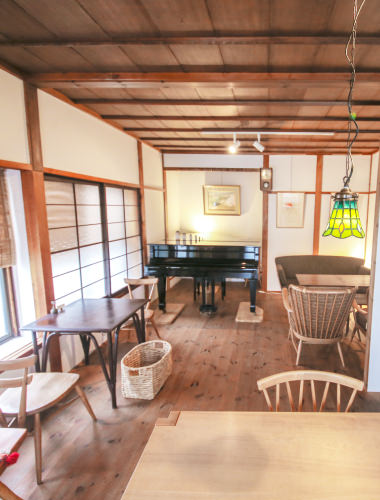
There is also a gallery in the room behind the staircase. Artworks by artists from both Aomori and beyond are on display here.
- Café Rural
- Opening Hours: 10:30-16:00 (Last Order 15:30)
- Closed: Tuesdays and Wednesdays *Closed for winter from early November until the beginning of April
- Tel. 0172-85-2213
-
166-3 Kanda, Tashiro, Nishimeya, Nakatsugaru District, Aomori Prefecture
From the Hirosaki Bus Terminal, take the Konan bus Nishimeya-mura Yakuba-mae line. 7-minute walk from Nishimeya-mura Yakuba-mae bus stop.

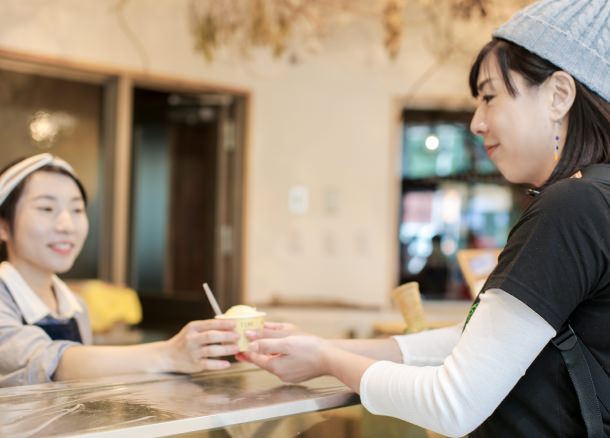
Honey and Icecream at Michi-no-Eki Tsugaru Shirakami
BeFavo is a shop in Michi-no-Eki Tsugaru Shirakami that makes its own ice cream and Italian gelato, which customers can top with honey from Shirakami Sanchi. Honey quickly energizes you and is perfect for eating just after trekking. The honey is collected from a beehive that was installed on the roof of the building!
- BeFavo
- Opening Hours: 9:00-17:00 (May change depending on the season)
- Tel.080-2837-4580
-
219-1 Kanda, Tashiro, Nishimeya, Nakatsugaru District, Aomori Prefecture
Michi-no-Eki Tsugaru Shirakami, Inside Beech Nishimeya
From the Hirosaki Bus Terminal, take the Konan bus Nishimeya-mura Yakuba-mae line. 6-minute walk from Nishimeya-mura Yakuba-mae bus stop.


